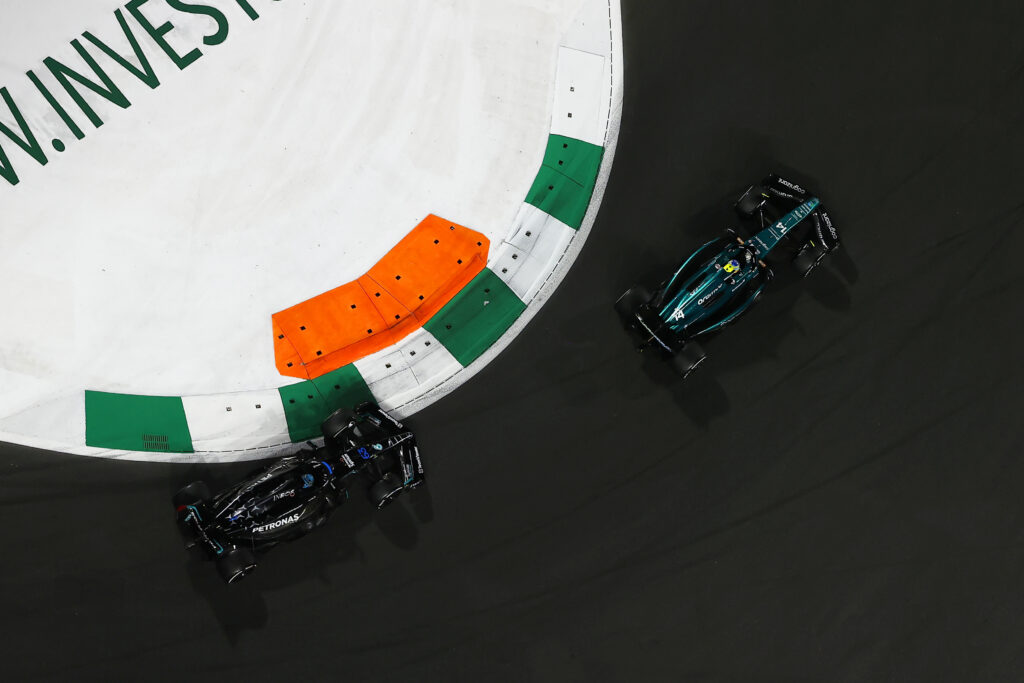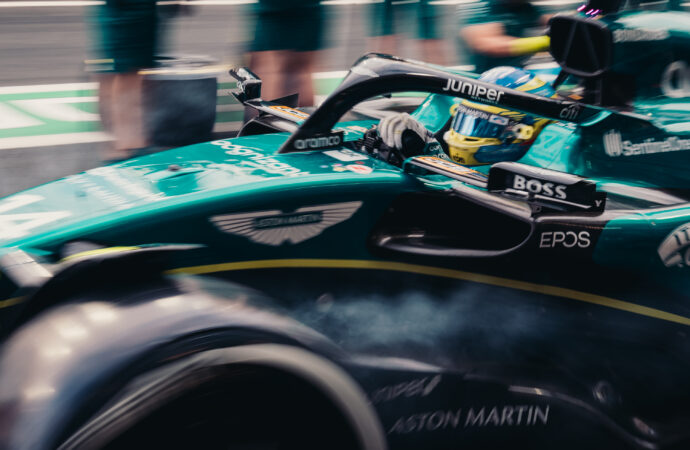A good start to the F1 season has been mirrored by the attainment of FIA three-star Environmental Accreditation and ISO 14001. Aston Martin F1’s sustainability team explain how
As Sebastian Vettel flashed across the finish line at the 2022 Abu Dhabi Grand Prix – in the points with a tenth-placed finish – it brought the curtain down on one of the most successful careers in the history of F1. Perhaps, more notably, Vettel will go down in history as the first F1 driver to step back from the action with his concern about the climate crisis as a key motivation for doing so.
And while the retirement of the four-time World Champion gave his team, Aston Martin F1, a problem to solve in terms of filling his seat for the 2023 season, evidence suggests that its ability to compete on the track, as well as its appetite for environmental responsibility, hasn’t diminished as we move through the early stages of the new campaign.
Vettel’s replacement, Fernando Alonso, has secured three podium finishes in three races, while off the track Aston Martin F1 has attained both three-star FIA Environmental Accreditation and the ISO 14001 Environmental Management Standard.
With Alonso (himself a two-time World Champion) joining Lance Stroll to spearhead the team’s charge in the Constructors Championship, Parveer Ramana (sustainability and environmental lead) and Simon Randall (head of sustainability, safety and estates) were drafted in to support and enhance the sustainability work started by ESG consultant Debbie Wall.
The trio feel that both aspects – performance and sustainability – go hand-in-hand in F1.
An investment in renewable energy, Ramana says, will reduce the cost per part when it comes to manufacturing the car – extremely beneficial in the era of F1 cost cap regulations.
“If we were to put up three or four wind turbines to generate our own energy that would obviously be great from a sustainability perspective, but it also works from a cost and performance perspective because if the cost of the part is reduced, we can create more parts,” she adds.
Investments made specifically to reduce carbon impact and improve environmental performance are not currently excluded from the cost cap regulations, but dialogue is opening up to see if that could be a possibility, particularly in the context of F1’s own environmental commitments.
The second link between sustainability and performance is people. Quoting the team’s chief people officer, Heath Cade, Wall says: “If we don’t do this stuff, we can’t recruit the talent we need to make the car go faster and become World Champions.”
“For us it’s a non-negotiable,” Wall adds in her own words. “Martin Whitmarsh (Group chief executive of Aston Martin Performance Technologies) has been pioneering this. When I heard he was going to be coming in, I was almost outside the building cheering because I knew sustainability would be absolutely top of his agenda.”
The former McLaren Racing boss was part of the Global Advisory Board that helped shape Formula E after its embryonic years and also co-founded BAR Technologies, which developed low carbon innovation for the marine industry.
But as fans of ‘Drive to Survive’ will know, the team behind the team is absolutely critical when it comes to success on the track – and the same principle applies to sustainability.
Ramana and Wall explain that the team went from a “standing start” to achieving the FIA’s three-star accreditation – its highest rating – in a “really short period of time”. To achieve a three-star rating, according to the FIA, means to demonstrate best practice and a “commitment to continually seek improvement” through the implementation of an environmental management system.
The transformational picture they paint showcases that progress. When Ramana joined Aston Martin F1 in July 2022, everyone had an individual bin under their desk. Now, she’s often stopped in the corridor by colleagues from different departments with ideas about how to improve things environmentally.
“It’s testament to the people here and the enthusiasm of all our employees,” adds Ramana, who has a background in climate science. “As an environmental professional, it’s so nice to experience that. It’s a totally different energy.”

A positive internal culture towards environmental responsibility has been fostered in three ways: through structure, education and empowerment.
Structure was provided through the ISO 14001 Environmental Management System that requires processes and objectives to be set throughout the business. When Wall first joined the team shortly after it became Aston Martin F1, her first priority was to establish frameworks and management processes to embed sustainability into everyday decision making. This was taken on by Ramana and Randall, who came from the process-heavy construction and manufacturing industries respectively.
However, structure without education isn’t enough. So the team started to “upskill” colleagues with regular sessions on sustainability and how they could support organisational goals as departments and individuals.
“Bridging the knowledge gap underpins all the work we’re trying to do with multiple stakeholders,” Ramana explains. “We’re trying to bring everyone’s knowledge up regarding climate science and anthropogenic global warming so they understand why it’s so crucial to take action.”
From a carbon reduction point of view, there are two major issues at the top of the team’s priority list, namely logistics – which accounts for 72% of F1’s baseline footprint – and supply chain. For the latter, a shift from air to sea freight has helped reduce costs as well as carbon. And a piece of sustainable supply chain management technology called Calathea is helping to keep tabs on the carbon emissions of partners producing goods for the team.
A new factory – dubbed F1’s first “smart factory” – will be Aston Martin F1’s home from May this year. Facility operational elements such as an integrated energy usage monitor will be coupled with the implementation of green travel schemes for employees to reduce HQ emissions as much as possible.
“There’s a lot of managing up and managing down because the work we’ve had to do around ISO 14001 and the FIA three-star accreditation has included every single department,” says Wall. “Without collaboration we wouldn’t have succeeded.
“For us, it’s about walking the walk and talking the talk, staying pretty humble and making sure we’re getting it right.”
When Vettell walked away from the sport six months ago, he said there’s “no way” F1 or any sport can avoid climate change. Things would “have to change”, he said. How apt it would be if he former team was a key protagonist in making that change.
Opt into our weekly newsletter for exclusive content focused on sustainability strategy, communication and leadership for sport’s ecosystem.










Leave a Comment
Your email address will not be published. Required fields are marked with *